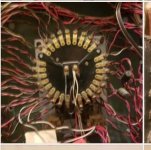Hi. I'm working on an old low voltage lighting control system. It has about 45 or so Leviton 24v GE RR7 relays mixed with P&S 1070B relays.
But adjacent to the panel housing the relays are 2 enclosures, each with a round multi pole (probably 50) relay. I'll try to attach the picture.
The enclosures are marked Master relay 1 and master relay 2. I've never seen one like these before. Any one have experience on these?
I'm fine with rr7 and 1070B, just don't see the need for these Masters unless its used for ALL OFF or ALL ON ?
Pictures won't load....
But adjacent to the panel housing the relays are 2 enclosures, each with a round multi pole (probably 50) relay. I'll try to attach the picture.
The enclosures are marked Master relay 1 and master relay 2. I've never seen one like these before. Any one have experience on these?
I'm fine with rr7 and 1070B, just don't see the need for these Masters unless its used for ALL OFF or ALL ON ?
Pictures won't load....


